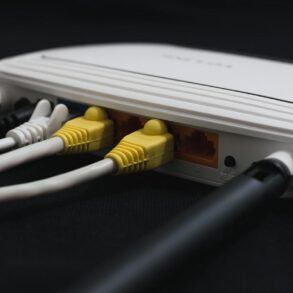Network devices including switches and routers use a variety of protocols and algorithms to exchange information and to transport data to its intended endpoint. Every endpoint (sometimes called a host) in a network has a unique identifier, often an IP address or a Media Access Control address, that is used to indicate the source or destination of the transmission. Endpoints can include servers, personal computers, phones and many types of network hardware.
Wired and wireless technologies
Networks may use a mix of wired and wireless technologies. Network devices communicate through a wired or wireless transmission medium. In wired networks, this may consist of optical fiber, coaxial cable or copper wires in the form of a twisted pair. Wireless network pathways include computer networks that use wireless data connections for connecting endpoints. These endpoints include broadcast radio, cellular radio, microwave and satellite.
Networks can be private or public. Private networks require the user to obtain permission to gain access. Typically, this is granted either manually by a network administrator or obtained directly by the user via a password or with other credentials. Public networks like the internet do not restrict access.
LANs, WANs, MANs and SANs
Networks may also be categorized by the scope of their domains. Local area networks (LANs) interconnect endpoints in a single domain. Wide area networks interconnect multiple LANs, and metropolitan area networks interconnect computer resources in a geographic area. Storage area networks interconnect storage devices and resources. Networks may also be divided into subnetworks, also called subnets.
Network protocols and standards specify exactly how data should be transmitted and received. Modern, packet switched networks use protocols – TCP/IP being the most widespread – to establish a standard means of communication. The Ethernet standard establishes a common language for wired networks to communicate; the 802.11 standard does the same for wireless LANs.
A network’s capacity – that is, how much traffic it can transmit at any one time – is measured in terms of bandwidth. Bandwidth is quantified by the theoretical maximum number of bits per second that can pass through a network device. Throughput is a measure of the actual speed of a successful transmission after accounting for factors like latency, processing power and protocol overhead.
Types of computer network topologies
- Partial mesh networks, in which some of the nodes are connected to each other in a full mesh scheme, but others are only connected to one or two other nodes in the network.
- Point to point networks, which is a connection between only two endpoints.
- Network fabric, in which endpoints transfer data to each other through interconnecting switches and can connect to any other by taking a path through a criss-cross pattern of connections.
- A Bus, a circuit arrangement where all network devices are attached directly to a transmission line directly, and while all signals pass through all devices, each device has a unique identity and recognizes signals intended for it.




